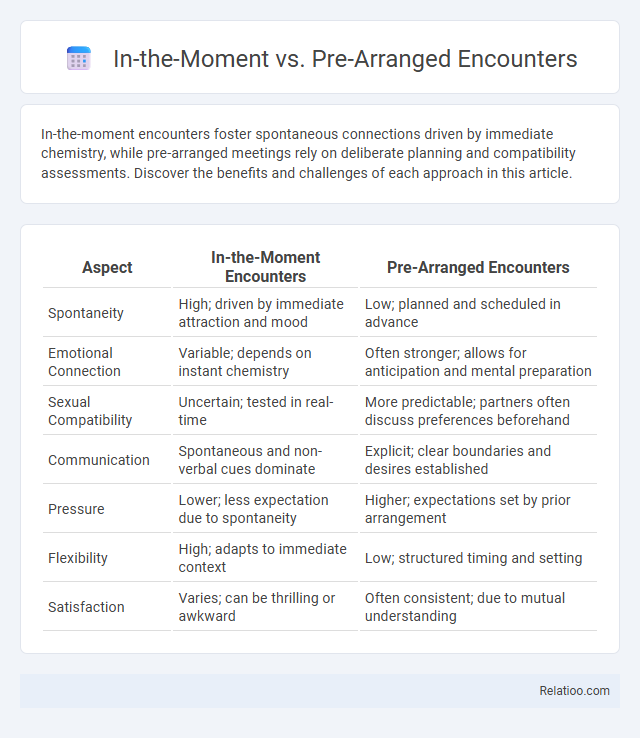In-the-moment encounters foster spontaneous connections driven by immediate chemistry, while pre-arranged meetings rely on deliberate planning and compatibility assessments. Discover the benefits and challenges of each approach in this article.
Table of Comparison
| Aspect | In-the-Moment Encounters | Pre-Arranged Encounters |
|---|---|---|
| Spontaneity | High; driven by immediate attraction and mood | Low; planned and scheduled in advance |
| Emotional Connection | Variable; depends on instant chemistry | Often stronger; allows for anticipation and mental preparation |
| Sexual Compatibility | Uncertain; tested in real-time | More predictable; partners often discuss preferences beforehand |
| Communication | Spontaneous and non-verbal cues dominate | Explicit; clear boundaries and desires established |
| Pressure | Lower; less expectation due to spontaneity | Higher; expectations set by prior arrangement |
| Flexibility | High; adapts to immediate context | Low; structured timing and setting |
| Satisfaction | Varies; can be thrilling or awkward | Often consistent; due to mutual understanding |
Understanding In-the-Moment Encounters
In-the-moment encounters emphasize genuine, unplanned interactions that foster authentic connections by responding to immediate circumstances and emotions. Unlike pre-arranged engagements that rely on prior planning, these encounters thrive on spontaneity, allowing for natural and often more meaningful experiences. Understanding in-the-moment encounters highlights the value of being present and open to unexpected opportunities, enhancing relational depth and emotional resonance.
What Are Pre-arranged Encounters?
Pre-arranged encounters refer to meetings or activities that are scheduled in advance, allowing participants to prepare and set clear expectations. These encounters provide structure and reliability, often improving coordination and communication between involved parties. In your planning, balancing pre-arranged encounters with spontaneity can enhance flexibility while maintaining organization.
Key Differences Between Spontaneity and Planning
Spontaneity involves immediate, unplanned decisions driven by impulse and the desire for novel experiences, while pre-arranged encounters rely on deliberate planning and coordination. In-the-moment interactions often foster authentic connections and flexibility, contrasting with the structured nature of scheduled events that prioritize predictability and preparation. The key difference lies in control--spontaneity embraces uncertainty and adaptability, whereas planning emphasizes order and anticipation.
Psychological Impacts of Each Encounter Style
In-the-moment encounters often trigger heightened emotional responses and increased dopamine release, enhancing feelings of excitement and novelty. Pre-arranged encounters provide a sense of control and predictability, which can reduce anxiety but potentially limit emotional spontaneity and deep connection. Spontaneity fosters creativity and resilience by encouraging adaptive thinking, though it may also induce stress in individuals who prefer structured environments.
Benefits of In-the-Moment Connections
In-the-moment connections offer the benefit of authentic, unfiltered interactions that foster genuine emotional bonds and heightened presence. These spontaneous encounters improve social skills by encouraging adaptability and mindfulness, enhancing your ability to connect deeply without preconceived expectations. Embracing in-the-moment connections cultivates a more fulfilling social life, as you experience relationships as they naturally unfold.
Advantages of Pre-arranged Meetings
Pre-arranged meetings offer the advantage of structured communication, enabling participants to prepare thoroughly and set clear objectives, which enhances productivity and decision-making efficiency. Scheduling encounters in advance ensures the availability of key stakeholders, minimizing conflicts and maximizing attendance, leading to more effective collaboration. This approach supports professional courtesy and reduces uncertainties, fostering a sense of reliability and trust among participants.
Potential Drawbacks and Challenges Compared
In-the-moment encounters often lack preparation, leading to potential miscommunications and unmet expectations that can strain social dynamics. Pre-arranged encounters provide structure but may reduce spontaneity, causing interactions to feel scripted or less authentic. Spontaneity, while fostering genuine and dynamic experiences, carries the risk of unpredictability and logistical complications, which can hinder reliable social engagement.
Situations Best Suited for Spontaneous Encounters
Spontaneous encounters thrive in unpredictable environments where flexibility and quick decision-making are essential, such as networking events, social gatherings, or travel experiences. Your ability to embrace the moment fosters genuine connections and serendipitous opportunities that pre-arranged meetings might lack. These situations benefit most from spontaneity due to their dynamic nature and the potential for unexpected interactions.
When to Choose Pre-arranged Over Spontaneous
Pre-arranged encounters ensure clear expectations and coordination, making them ideal when You require reliability and planning, such as business meetings or formal events. Choosing pre-arranged meetings reduces uncertainty and allows participants to prepare adequately, enhancing productivity and communication. Opt for spontaneous encounters when flexibility and creativity are paramount, but rely on pre-arrangements to guarantee timely and goal-oriented interactions.
Finding the Right Balance for Meaningful Interactions
Balancing in-the-moment encounters, pre-arranged meetings, and spontaneity fosters more meaningful interactions by combining intentional planning with the excitement of unplanned connections. Structured engagements ensure purposeful communication and goal alignment, while spontaneous moments encourage authenticity and creative exchanges. Prioritizing flexibility within schedules enhances relationship quality, blending predictability with the freshness of surprise.

Infographic: In-the-moment vs Pre-arranged Encounters
 relatioo.com
relatioo.com